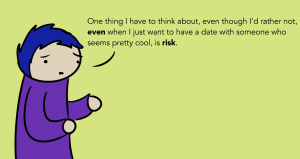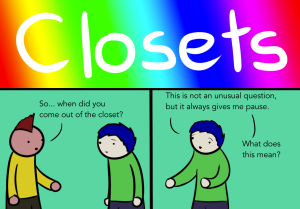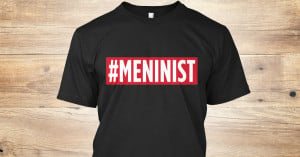(Content Warnings: Suicide, PTSD)
I’ve heard a lot of debate around content warnings (popularly but problematically referred to as trigger warnings) – and I’ve got to say, I’m stunned. Who knew a simple request could cause this much of a stir?
If you’re not familiar, a content warning is a very simple statement at the beginning of an article, film, or comic that lets the audience know that something potentially distressing will appear in the content they’re about to consume.
Some pretty common ones include sexual assault, alcohol consumption, or violence. If someone has trauma around one of these areas, and could find themselves triggered by the material, it allows them to opt out or brace themselves before they have a traumatic reaction to it.
For example, a dear friend of mine is a suicide attempt survivor. In the years after her attempt, she tried to avoid articles and movies that had some kind of detailed reference to suicide.
Because she had post-traumatic stress disorder (PTSD) as a result of her attempt, engaging with anything that included suicide would cause a panic attack and flashbacks, and it was very harmful for her mental health and recovery.
For me, content warnings are sort of a no-brainer. As a writer, I want to make sure that my content isn’t harming my audience, and that I’m sensitive to the needs of those who are still trying to heal from trauma or dealing with a disability like PTSD, anxiety, or a phobia.
Life is already difficult for survivors, so why make it harder?
But there is a lot of resistance still, despite it being a fairly simple request. So I want to explore that opposition – namely, what we’re actually saying to folks with disabilities and trauma when we ignore or mock their requests for content warnings.
You may not be literally saying these things, but the following might be implied whenever you dismiss a survivor of trauma.
1. Adding a Couple of Words at the Beginning of My Content Is So Hard
Many people talk about the inconvenience of content warnings. As a writer, I’m calling bullshit on that.
Even if writing an additional sentence at the beginning of my article were difficult (which it’s not), it will never compare to the inconvenience of a serious panic attack, a flashback, or a dissociative episode that a survivor might have if they encounter a trigger in my work.
As writers, filmmakers, content creators, or even educators, we regularly encounter demands on our work. Some people can ask for the most ridiculous things. But a sentence at the beginning of our work or syllabus? A sentence to help survivors preserve their mental health? I’d say that’s the least bizarre or inconvenient request I’ve ever gotten.
2. PTSD? Lolz, Who Cares
Many of the folks who request content warnings are people dealing with PTSD. Symptoms of this disorder can be very debilitating, including panic attacks, dissociation, flashbacks, hyperarousal, and difficulty sleeping.
Content warnings can be important for people with PTSD who are trying to avoid content that may trigger one of their episodes.
When people oppose content warnings – treating them as though they are frivolous requests coming from oversensitive people – they completely undermine the seriousness of conditions like PTSD.
What you’re saying to survivors is that PTSD isn’t a condition that you recognize or care about, and that you have no interest in helping folks who are dealing with such a devastating disorder.
Content warnings make content more accessible for people with PTSD because it allows them to have fair warning and choose to engage with that material when they’re in a place that allows them to do so.
When you oppose those warnings, you’re saying that PTSD isn’t a legitimate enough condition to warrant a slight adjustment in how we present material so that folks dealing with this disorder can actually participate when they’re ready and able.
In other words, you’re suggesting that you just don’t care. And that’s pretty lousy.
3. I Really Want to Make Your Already Difficult Life More Difficult
I’ve heard a lot of folks who oppose content warnings saying to me, “Welcome to the real world! If you can’t deal with this article, how are you going to deal with real life?”
You don’t need to tell a survivor that “the real world” is hard, because they already know that. They’re already living in it, trying to survive and trying to heal. And your refusal to include content warnings takes already difficult circumstances and makes them even harder.
What’s the problem with making writing, film, and (yes) classrooms more accessible for people with trauma? Even if the rest of the world is going to be a challenge, why add an additional struggle onto their plate?
It’s like forcing someone to wear heavy weights while they run a marathon, under the guise that “running is hard, and if you can’t deal with the weight, maybe you shouldn’t run a marathon!”
Yes, the real world sucks. Survivors know that better than anyone. So we should work hard to make safe spaces wherever it’s possible to do so – especially when it’s as easy as adding a content warning.
4. Go Ahead, Have a Panic Attack Today
If you’re not interested in preventing a panic attack, especially when it’s so easy to avert, it kind of sounds to me like you don’t care if it happens.
I’m just saying.
5. I Don’t Think Making My Content Accessible Is All That Important
Folks with disabilities like PTSD, anxiety, and phobias deserve to be able to make educated decisions about whether or not they engage with triggering content.
It allows them to access your work or your classroom – namely, by ensuring that they are in the right place to participate.
We label the deep end of a swimming pool, for example, so that folks who can’t swim can make a smart decision about whether or not they should be on that end of the pool. We create ratings for movies so that parents can decide if their children should be watching violent films. We label foods that have allergens so that folks with allergies can decide if they should eat that particular food.
We would never tell someone who can’t swim that they’re “too sensitive” for asking how deep the water is, tell a child “welcome to the real world” as we turn on a horror film, or tell someone with allergies to just “get over it” and eat some peanut butter.
Content warnings operate on the same principle. They’re there to prevent danger or distress, so that, like labeling the deep end of a pool, people can make smart choices about where they’re going to swim (or, in this case, what they’re going to read or watch).
Content warnings make content more accessible by allowing people to make the right choice and avoid threatening situations that can jeopardize our mental health. It’s not unreasonable to ask for those warnings, especially when they impact a great number of people.
6. Stigmatizing Mental Health Conditions Is a Cool Hobby of Mine
Telling people with serious disorders like PTSD, anxiety, or phobias to just “deal with it” or trivializing it by saying they’re being “too sensitive” upholds a lot of negative stereotypes about what these mental health issues really look like.
Mental illness is not about being too sensitive or about being politically correct. Mental illness is a serious and valid struggle, and writing it off as silly or making a meme out of it completely trivializes what should be a very serious deal.
When you act like content warnings are just a silly request, what you’re really saying is that mental illness and the people who are surviving with it every day are just “silly.”
I don’t know about you, but I don’t think that night terrors and insomnia, repeated flashbacks of the worst moment in your life, and panic attacks that leave your hands numb and your breathing restricted are all that funny.
Instead of treating mental health struggles as a joke, we need to treat it with the seriousness that it deserves. And if that’s a little inconvenient, so be it.
7. I Like to Ignore My Audience and My Impact
If you don’t care about the impact that your work has on the community that you are serving – whether it’s with your articles or your films or a lesson you give in your classroom – what exactly is the point of what you’re doing?
As a writer, I’m concerned if there are people who can’t access my content and learn from it because each time that they try to, they are harmed by what I’ve put out into the world. As a writer, I’m concerned if my impact is way different than my intention.
I recognize that I won’t make every single person happy with my writing. There will always be individuals who are a bit disgruntled. But I also recognize that when a community calls on me to make my content better, I should tune in and see if there’s a way that I can do it.
Entire communities have called on us to include content warnings because it’s a significant enough concern to unite around. Instead of ignoring that, I feel that I and other content creators have a responsibility to tune in.
We should think critically about who our work is serving. And if our work is not accessible to everyone, and if there is a community that is negatively impacted by what we’re doing, we should think about ways that we can make our work better so that anyone and everyone can participate.
There’s a big difference between being displeased with your work and actually being harmed by it. And if there’s an easy way to prevent that harm, and to include more people in our work, I think it’s worth doing.
Otherwise, who are we serving? And more specifically, who are we excluding?
8. Your Trauma Doesn’t Matter to Me
Ultimately, the big takeaway that many folks have when you refuse to include content warnings is that the trauma that they have experienced isn’t important to you.
Whether it was a veteran who just barely made it out of combat alive, a black man who was the victim of a vicious hate crime, or a woman who was violently sexually assaulted, what you’re saying to them is that what they’ve been through and what they need to survive is completely and utterly unimportant to you.
And if you aren’t the slightest bit concerned about that message, there’s some deeper reflection that needs to happen.
Because while no one is asking you to fix their struggles for them or hold their hand, what they are asking is that you care enough to write a single sentence on that article or in that syllabus, just enough to give them the chance to opt out or put some self-care in place if they need to.
Their request isn’t ridiculous.
What’s ridiculous is that people are still debating about this, as if your convenience trumps their trauma.
***
So I’m a little passionate about content warnings, if you couldn’t tell.
I’m passionate because it can make a world of difference for folks who are already struggling. It’s so easy, and yet it can be the difference between a decent day and a day ridden with panic and dysfunction.
While we can’t reasonably have a content warning for every single trigger that exists, I don’t think it’s difficult to have some guidelines – some very basic warnings that folks can abide by so that we can prevent some of the harm that is done to survivors of trauma.
Many platforms, including right here at Everyday Feminism, have already made the shift. And guess what. It was no big deal.
It’s not about censoring our work – a “heads up” doesn’t censor anything, just the way that labeling the deep end of the pool doesn’t magically change the depth of the pool, or labeling allergens doesn’t change the ingredients in the food but rather, identifies them.
I am committed to including content warnings when I can because I believe that survivors deserve to make educated decisions so that they can manage their health and wellbeing. When a community comes together and asks us to do right by them, I think we have an obligation to do our best to respond.
And honestly? With a measure that is so simple, the bottom line is that there’s just no good reason not to.
[do_widget id=’text-101′]
Sam Dylan Finch a Contributing Writer for Everyday Feminism. He is queer writer, activist, and educator based in the San Francisco Bay Area. In addition to his work at Everyday Feminism, he is also the founder of Let’s Queer Things Up!, his hella queer and very awesome blog. You can learn more about him here and read his articles here. Follow him on Twitter @samdylanfinch.
Search our 3000+ articles!
Read our articles about:
Our online racial justice training
Used by hundreds of universities, non-profits, and businesses.
Click to learn more





















